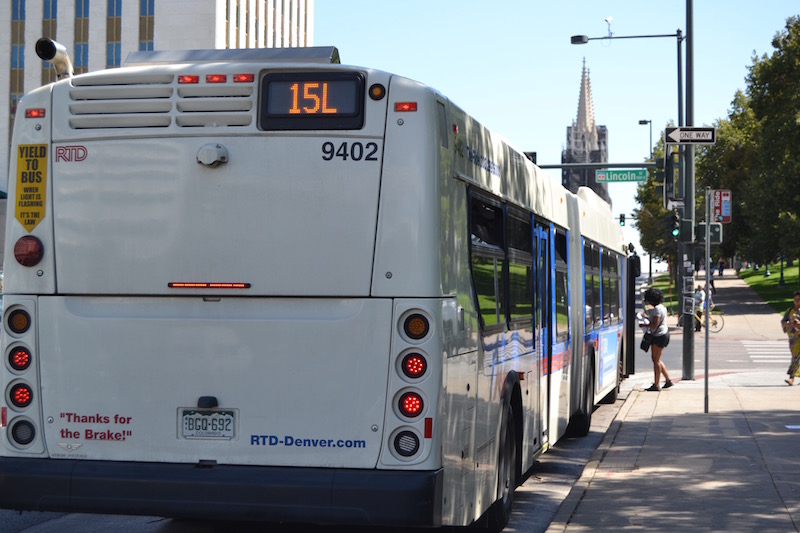Neil Westergaard: “Dirty,” “Smelly,” “Dangerous” Bus Riders Will Repel People from Colfax BRT
In an attempt to discredit the Colfax bus rapid transit plan, the Denver Business Journal boss resorts to lazy stereotypes.

Denver Business Journal Editor Neil Westergaard took aim at buses and bus riders last week in a column targeting the plan to improve transit on Colfax Avenue.
It’s no secret that Westergaard views city streets as a kind of cultural war zone where your mode of travel dictates your tribe. He pigeonholes people who bike as rabid environmentalists while casting people who drive as an oppressed majority just trying to dodge obstructions (like, say, other people) that Big Brother puts in their way.
But in his most recent column — behind a paywall of $115 per year — Westergaard takes things to another level. In an attempt to discredit the Colfax bus rapid transit plan, among other city efforts to improve transit, biking, and walking, the boss of one of Denver’s most influential media outlets resorts to lazy stereotypes.
“People don’t choose to ride the bus on Colfax… because they often have to put up with belligerant [sic], dirty, smelly, disruptive and dangerous people, all conditions which the bond issue doesn’t begin to solve,” Westergaard asserts.
I spoke with a few regular riders of the 15 and 15L to see how they feel about Westergaard’s column and the impending improvements to the bus line.
Jared Pittman was waiting to catch the 15 at the corner of Colfax and Park during morning rush hour, heading home after working all night. He doesn’t own a car and relies on RTD, which he says works fine.
“But to me [the improvements] would just make Colfax super rapid and efficient to where buses are just running constantly,” he said. “You have a high population of homeless people that have lost the ability to care for themselves, absolutely, but it’s a city and these are city problems.”
Jess Curry was at the same stop waiting for the same bus. He has a car, but his wife uses it mostly. Asked about improvements like dedicated bus lanes, he said, “That’ll be good. I think that’s great but it needs to be more than just the 15. It needs to be the whole system.” Curry added, frustrated, that sometimes the bus is too full to board. To put this in terms Westergaard might understand, this is like a road being full of cars to the point of immobility. Colfax needs more capacity for buses.
I also spoke to Eric Haglund, who owns a car but rides the bus along Colfax from Mayfair to work and back three or four days a week. He looks forward to the BRT line. “I have a car, I could drive to work, but I don’t want to deal with parking, I don’t want to deal with traffic,” Haglund said. “It would take about the same amount of time to drive down there and I would much rather read a magazine article or listen to a podcast than deal with traffic.
“In the broader perspective of safety, I think I’d much rather be on a bus with some colorful characters than on a street where people get road rage and they’re driving around with thousands of pounds of metal.”
Rather than present data or engage with the experience of actual bus riders, Westergaard asserts that better bus service won’t attract more ridership because… well, he just knows, don’t ask how. “But will more people ride the bus just because there’s a dedicated bus lane?” he writes. “I don’t think so. People eschew the bus for lots of reasons, but not having dedicated lanes ain’t one of them, in my opinion.”
The data from other American cities says otherwise — faster, more reliable bus service does make a difference. On Seattle’s six “Rapid Ride” routes, which feature bus lane segments, priority at traffic signals, off-board fare collection, and other service enhancements, bus ridership increased a total of 43 percent between 2010 and 2014. In Cleveland, the Healthline BRT project, which features center-aligned bus lanes similar to what Denver is planning for Colfax, saw a 45 percent increase in ridership in its first year and a 60 percent increase since it debuted in 2008.
In Denver, we know that Colfax is the busiest bus corridor in the city, with more than 22,000 trips per day. The fact that such high ridership occurs without bus-only lanes, dignified bus stops, speedy off-board payment, or traffic signals that prioritize buses at intersections tells us something: Demand for transit on Colfax is so high lots of people put up with less than ideal service. Bus lines like this — high ridership on an overburdened route — are exactly where transit experts say service enhancements will deliver the most bang for the buck.
The Colfax BRT project will improve speed, reliability, and frequency. Add it all together and not only will current riders get better service, but more people will be able to reach more places, faster.
Investing in transit improvements like Colfax BRT is all the more important as Denver’s population increases. As this graphic from the National Association of City Transportation Officials makes clear, bus lanes and exclusive transit lanes can move a growing city much better than regular old mixed-traffic lanes where cars rules.

Or maybe Westergaard’s hunch is right — transit models proven in other American cities just won’t work in Denver because of Bus People, or something.


